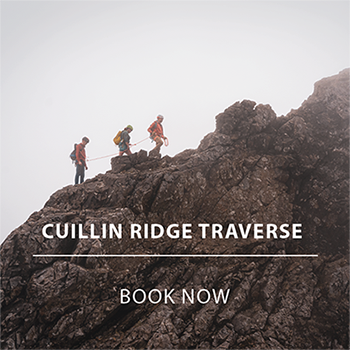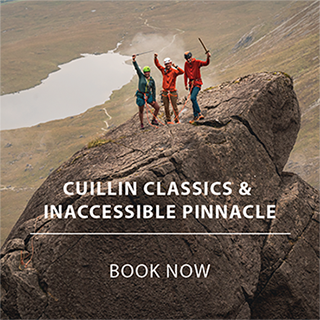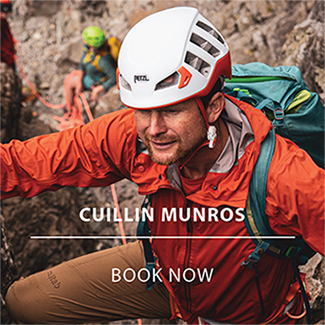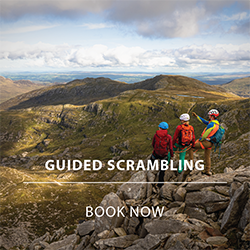How Hard is the Inaccessible Pinnacle?
Widely considered the hardest Munro, the ‘In Pinn’ is a superb undertaking for the aspiring mountaineer or climber. Here is your guide to the Inaccessible Pinnacle.
When should I go?
This course can run anytime May-Oct, but we recommend May to mid-June, and September each year. This is to:
a) maximise chances of getting favourable weather;
b) avoid the worst of the midges in mid summer; and
c) avoid the peak tourist season
It can still be busy on weekends and bank holidays. During these times, going early – or late – in the day can avoid the crowds.
What is the Inaccessible Pinnacle?
The Inaccessible Pinnacle (sometimes abbreviated to ‘In Pinn’) is the only Munro that requires rock climbing to reach the summit making it ‘Britain’s hardest Munro’. However, with our fully qualified and professional guides, it is well within the reach of a normal fit hillwalker with scrambling experience.
Where is the In Pinn?
The In Pinn is a fin of rock that sits atop Sgùrr Dearg (Gaelic for red peak), on the Cuillin Ridge, Isle of Skye, on the West Coast of Scotland.
Why climb the Inaccessible Pinnacle?
The Inaccessible Pinnacle is a must for anyone doing a round of the Munros, and a superb outing in it’s own right for aspiring mountaineers.
What route options are there?
East Ridge (Mod) 65m – this is a straightforward rock climb, typically done in 2 or 3 rope lengths (called pitches by climbers), with a 17m abseil off. The first half is steepest, with some bridging and a few committing moves. The second half feels easier, along a narrow whaleback, up to an open top and summit block. Your guide will place more protection on this second pitch to keep you safe as it has significant swing potential.
For experienced climbers there are other options:
West Ridge (Sev) 18m – A shorter but harder route that goes up beside the abseil line, the ‘Short Side’ is suitable for those with prior rock climbing experience. As it’s shorter, and you quickly abseil off the way you came up, it can be useful if the East Ridge is busy.
South Crack (Sev) 30m – This takes a more direct route up to the East Ridge, and is suitable for those with rock shoes and prior rock climbing experience.
History of The Inaccessible Pinnacle
The Inaccessible Pinnacle was first climbed by Lancashire brothers Charles and Lawrence Pilkington in 1880, famously throwing down loose rock as they ascended (thankfully it has got a lot better over the years!). While never climbed by Sir Hugh Munro himself, it has been high on the list for Munroists ever since – as well as those seeking one of the finest mountaineering adventures in Britain.
How difficult is the Inaccessible Pinnacle?
The Inaccessible Pinnacle is a graded, multi-pitch rock climb rather than a scramble.
What grade is the Inaccessible Pinnacle?
Via the the East Ridge (the easiest and most common route), the Inaccessible Pinnacle gets the lowest climbing grade of Moderate. While the moves are never hard, the route is exposed, with steep drops either side. However, as long as you can cope with some exposure to drops, a fit hillwalker with some scrambling experience will enjoy themselves on a guided ascent.
If a participant hasn’t rock climbed before, Summit Guides recommends a two day course – allowing skills to be introduced more progressively.
What happens on the day?
These timings would represent a normal day assuming dry conditions and no other hold ups:
7.00am You will meet your guide in the morning in Glen Brittle – often early to make the most of the day and beat the crowds. You will have met your guide the previous night if not before, and be fully briefed on kit, the route and what to expect.
7.30 - 9.30am Typically we then approach the Inaccessible Pinnacle using the West Ridge of Sgùrr Dearg, or Coire na Banachdich, putting on helmets and harness as we enter the scrambling terrain. As we summit Sgùrr Dearg, the Inaccessible Pinnacle comes into view – and we take a short break to enjoy the view, and make sure we have had some food and water before the challenge ahead.
9.30-11.30am It’s GO time! We make our way down some slabs, being careful not to knock any rocks off (roped up if wet) to the base of the climb.
We start our climb from here. Your guide will go up first trailing the rope, and build a belay anchor – then bring you up on a tight, secure rope. You will have to take the protection out as you go along – but you will be shown how to do this. While you might have to dig deep mentally as the exposure increases, most people find the experience exhilarating. Some are even inspired to come back for more rock climbing in the future!
At the top, remember to snap some pictures, before the guide arranges your roped descent.
11.30-12.00 Lunch. Proud of our achievement, we normally have the chance to watch other teams enjoy their own ascents.
12 onwards – Either on to other scrambling objectives such as the Munros of Sgùrr na Banchdich or Sgùrr Mhic Choinnich or descend back the way we came for a hot chocolate in the Sligachan!
Getting down again
Depending on experience, you may be lowered, or abseil down the rope. There is a large chain as an anchor at the top. Full training will be provided, and while many find the idea of committing their weight to a rope daunting, some people describe this as one of the highlights of their Inaccessible Pinnacle experience.
Where do I park?
Parking opposite the Glen Brittle Memorial Hut – we typically try and minimise traffic in Glen Brittle by sharing one vehicle.
How weather dependent is it?
The Inaccessible Pinnacle is best attempted in fine, dry conditions, as the polished basalt is somewhat slippery in the wet. Depending on client experience, the Inaccessible Pinnacle may be attempted in wet or windy conditions, but a more appropriate objective is likely necessary on safety grounds. On our 4 day Cuillin Munros course, we normally do the Inaccessible Pinnacle on the best weather day.
How big are the groups?
The Inaccessible Pinnacle is climbed on a 1:1 or 1:2 guide to client ratio so you will be very well looked after! Group bookings are available if you want to bring your friends, and we will supply extra guides as required.
Will there be time to take photos?
Yes! Experience shows that the best shots are from the side of the Pinnacle, at the first belay, on the very top, and as you abseil down. In the excitement many people forget to take photos – but your guide will take plenty in case you miss the moment!
What Kit do I need?
A full Kit List is here. Helmet, harness, and any technical gear is included in the cost. If it is wet, it is worth bringing a change of clothes to change into back at the vehicle. If it is dry, scrambling shoes are recommended for the Inaccessible Pinnacle as they make the scrambling easier: eg. La Sportiva Boulder X, La Sportiva TX4, Unparallel Rock Guide. However, boots will be necessary for wet conditions.
Further Resources:
MAPS: For the walk in, have a look at our route description on Fatmap:
BOOKS: For a description of the climbs on the Inaccessible Pinnacle, see:
Mike Lates, SMC Skye: The Cuillin, 2011
Gary Latter, Scottish Rock Vol 2: North, 2020 (3rd Edn)
Adrian Trendall, Skye’s Cuillin Ridge Traverse, 2020
YOU TUBE: This British Mountaineering Council TV video demystifies the Pinn and shows the ground you’ll cover:







